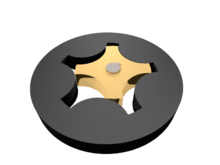Gerotor

A gerotor is a positive displacement pump. The name gerotor is derived from "Generated Rotor". A gerotor unit consists of an inner and outer rotor. The inner rotor has N teeth, and the outer rotor has N+1 teeth with N defined as a natural number greater than 2. The inner rotor is located off-center and both rotors rotate. The geometry of the two rotors partitions the volume between them into N different dynamically-changing volumes. During the assembly's rotation cycle, each of these volumes changes continuously, so any given volume first increases, and then decreases. An increase creates a vacuum. This vacuum creates suction, and hence, this part of the cycle is where the intake is located. As a volume decreases compression occurs. During this compression period, fluids can be pumped, or compressed (if they are gaseous fluids).
Gerotor pumps are generally designed using a trochoidal inner rotor and an outer rotor formed by a circle with intersecting circular arcs.[1]
A gerotor can also function as a pistonless rotary engine. High pressure gas enters the intake area and pushes against the inner and outer rotors, causing both to rotate as the area between the inner and outer rotor increases. During the compression period, the exhaust is pumped out.
History
At the most basic level, a Ge-rotor is essentially one that is moved via fluid power. Originally this fluid was water, today the wider use is in hydraulic devices. Mr. Myron F. Hill, who might be called the father of the Ge-rotor, in his booklet "Kinematics of Ge-rotors," lists efforts by a Mr. Galloway in 1787, by Messrs. Nash and Tilden in 1879, by Mr. Cooley in 1900, by Professor Lilly of Dublin University in 1915, and by Feuerheerd in 1918. These men were all working to perfect an internal gear mechanism with a one-tooth difference to provide displacement.
Mr. Hill made his first efforts in 1906, then, in 1921, gave his entire time to developing the Ge-rotor. He developed a great deal of geometric theory bearing upon these rotors, coined the word GE-ROTOR (meaning Generated ROTOR) and secured basic patents on GE-ROTOR.
Ge-rotors are widely used today throughout industry, and are produced in a variety of shapes and sizes by a number of different methods.
Uses
- Oil pumps
- Fuel pumps
- High speed gas compressors
- Engines
- Hydraulic motors
- Power steering units
See also
References
- ↑ "Gerotor Modeling with NX3" (PDF).
External links
- Nichols Portland Division of Parker Hannifin
- Pump School - Gerotor pump description and animation
- Step by step drawing
- Jennifer Kho (November 21, 2008). "Electricity from Waste Heat: Ener-G-Rotors' system harvests energy at lower temperatures". Technology Review. Massachusetts Institute of Technology (MIT). Retrieved 2008-12-02.